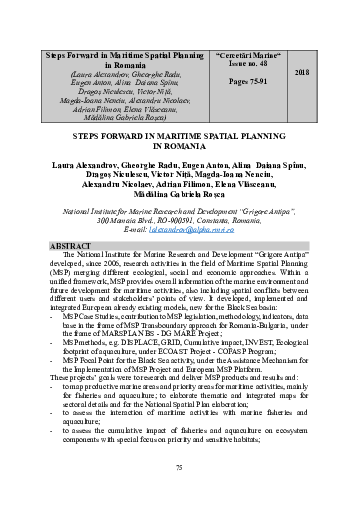Steps Forward in Maritime Spatial Planning in Romania
DOI:
https://doi.org/10.55268/CM.2018.48.75Keywords:
fisheries, aquaculture, spatial, temporal, assessmentAbstract
The National Institute for Marine Research and Development “Grigore Antipa” developed, since 2006, research activities in the field of Maritime Spatial Planning (MSP) merging different ecological, social and economic approaches. Within a unified framework, MSP provides overall information of the marine environment and future development for maritime activities, also including spatial conflicts between different users and stakeholders’ points of view. It developed, implemented and integrated European already existing models, new for the Black Sea basin:• MSP Case Studies, contribution to MSP legislation, methodology, indicators, data base in the frame of MSP Transboundary approach for Romania-Bulgaria, under the frame of MARSPLAN BS - DG MARE Project;
• MSP methods, e.g. DISPLACE, GRID, Cumulative impact, INVEST, Ecological footprint of aquaculture, under ECOAST Project - COFASP Program;
• MSP Focal Point for the Black Sea activity, under the Assistance Mechanism for the Implementation of MSP Project and European MSP Platform.
These projects’ goals were to research and deliver MSP products and results and:
• to map productive marine areas and priority areas for maritime activities, mainly for fisheries and aquaculture; to elaborate thematic and integrated maps for sectoral details and for the National Spatial Plan elaboration;
• to assess the interaction of maritime activities with marine fisheries and aquaculture;
• to assess the cumulative impact of fisheries and aquaculture on ecosystem components with special focus on priority and sensitive habitats;
• to measure economic and ecological performance of alternative spatial plans by scenario evaluations including delineating locations and space limits;
• to develop an operational modelling framework to analyze stakeholders’ behavior and predict their likely responses to spatial management options;
• to assess common opportunities and obstacles to integrate fisheries and aquaculture in MSP after stakeholder consultations.
This paper presents results obtained in the field of Maritime Spatial Planning in Romania, stressing the major contribution of NIMRD in spatial and temporal evaluation of fisheries and aquaculture in relation with environment and other maritime activities, due to new MSP methods implementing.

Downloads
Published
How to Cite
Issue
Section
License
This is an open access journal, which means that all content is freely available without charge to the user or his/her institution. Users are allowed to read, download, copy, distribute, print, search, or link to the full texts of the articles, or use them for any other lawful purpose, without asking prior permission from the publisher or the author. This is in accordance with the BOAI definition of open access.






